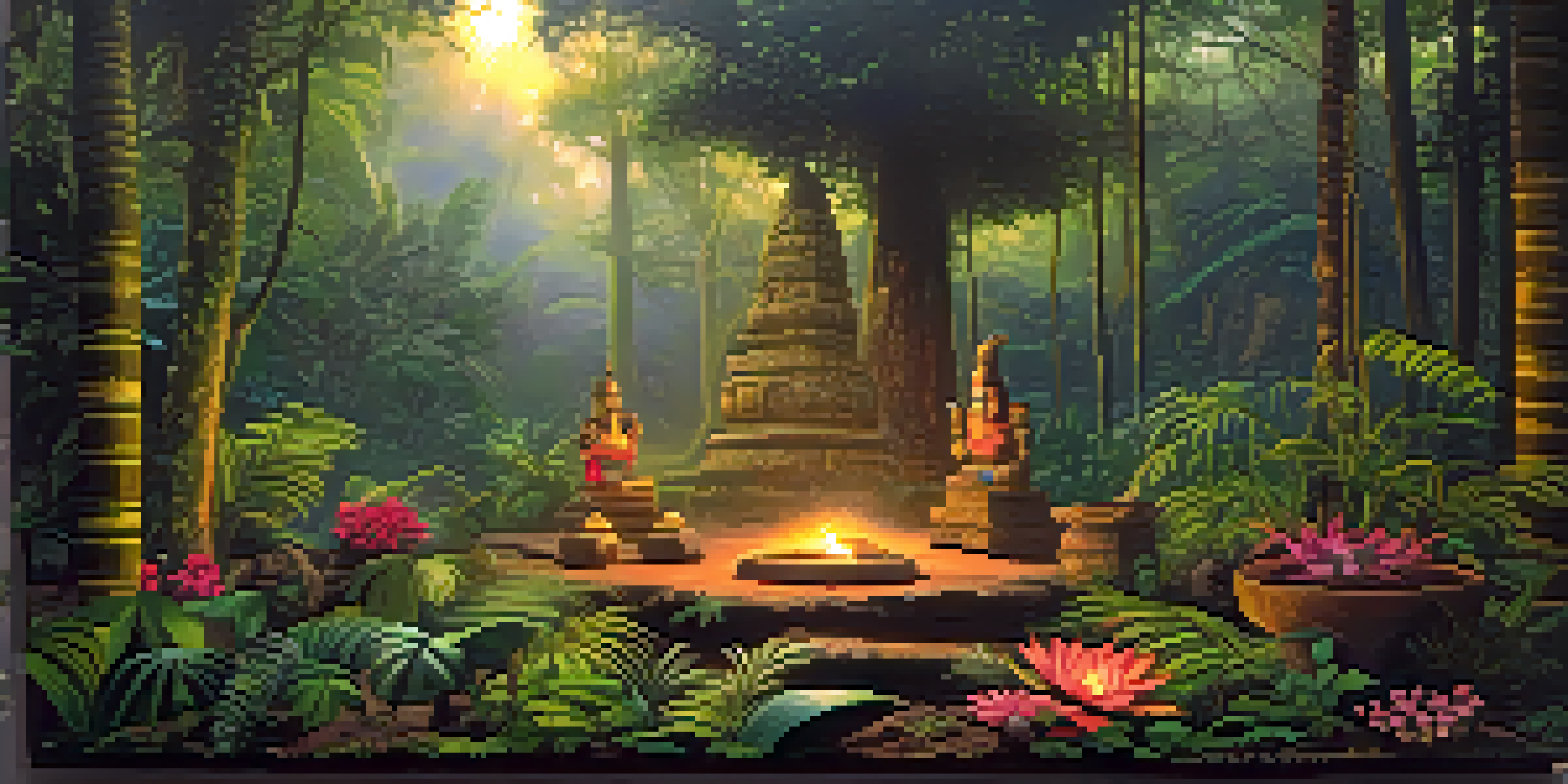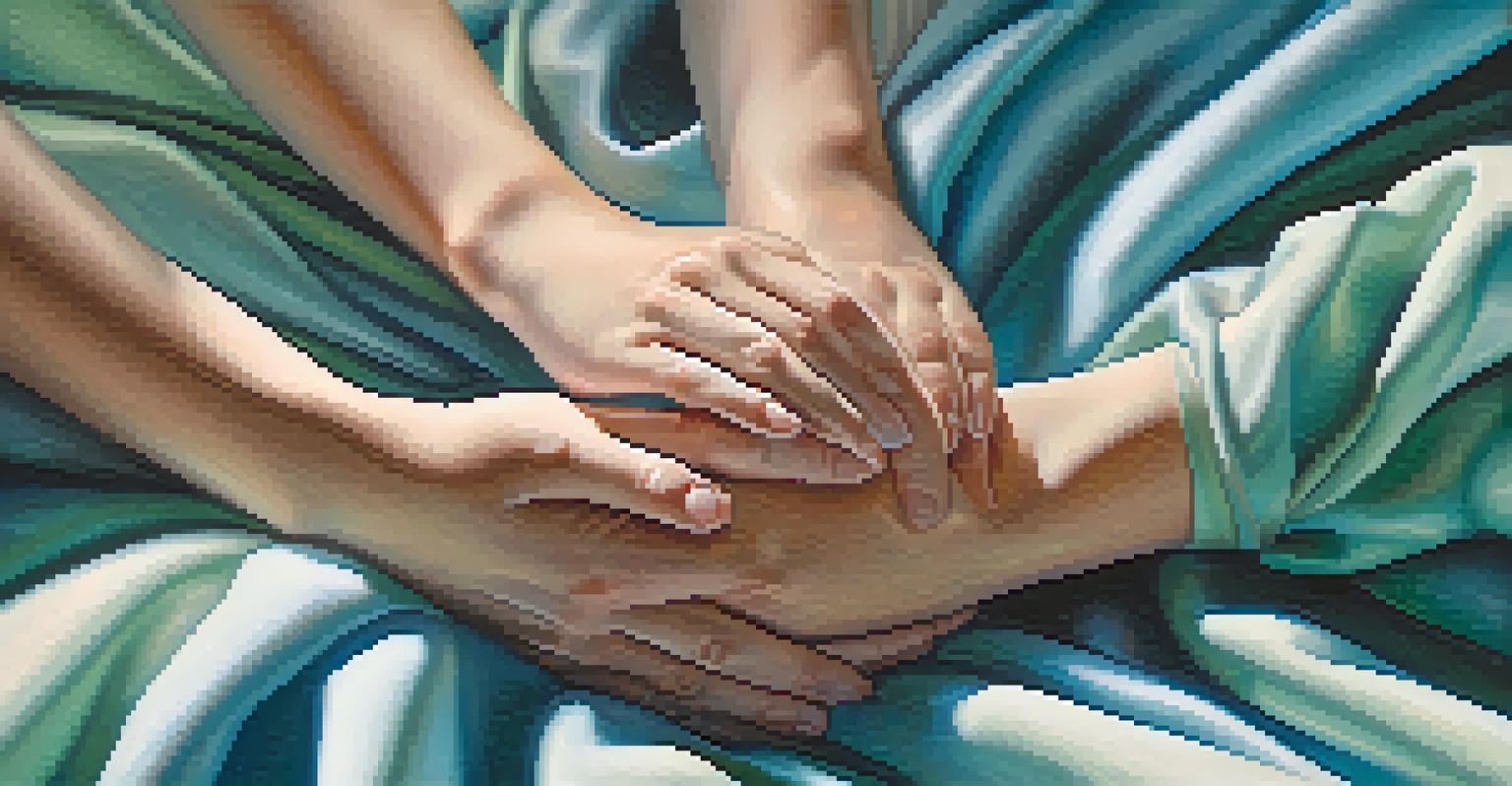Ayahuasca and Somatic Awareness: A Journey Within

What is Ayahuasca and Its Cultural Significance?
Ayahuasca is a powerful brew originating from the Amazon rainforest, traditionally used by indigenous tribes for spiritual and healing purposes. This sacred drink combines two main ingredients: the Banisteriopsis caapi vine and the leaves of the Psychotria viridis plant. Together, they create a psychoactive experience that many believe connects them to deeper spiritual truths.
The body is the instrument of our hold experience.
For centuries, Ayahuasca has been a central part of shamanic rituals, serving as a tool for guidance and self-discovery. Shamans, or spiritual healers, use it to navigate the spiritual realm and communicate with the spirits. This cultural backdrop adds layers of meaning to the Ayahuasca experience, making it more than just a substance but a revered practice.
In modern times, Ayahuasca has gained popularity beyond its traditional roots, attracting individuals seeking healing, insight, and transformation. While this has led to increased access, it's essential to approach it with respect for its cultural origins and the wisdom embedded in its use.
Understanding Somatic Awareness and Its Importance
Somatic awareness refers to the mindfulness of our bodily sensations and experiences. It is the practice of tuning into how our body feels, which can be incredibly grounding and insightful. By cultivating this awareness, we learn to recognize and process emotions that often manifest physically, providing an avenue to emotional healing.

Imagine your body as a finely tuned instrument; when you pay attention to its signals, you can identify areas of tension, discomfort, or even joy. This heightened awareness can lead to better emotional regulation and an improved sense of well-being. It’s like learning to listen to the whispers of your body instead of waiting for it to shout through pain or discomfort.
Ayahuasca: A Sacred Healing Brew
Ayahuasca is a revered drink from the Amazon, used by indigenous tribes for spiritual guidance and healing.
In a world that often prioritizes mental over physical health, somatic awareness offers a refreshing perspective. It encourages us to embrace our physical experiences as valid and significant, allowing us to connect with ourselves on a deeper level.
The Intersection of Ayahuasca and Somatic Awareness
When experiencing Ayahuasca, many individuals report profound shifts in their somatic awareness. The brew can heighten the senses and intensify feelings, prompting participants to become acutely aware of their bodily sensations. This connection can lead to powerful insights and a deeper understanding of the self.
Healing is a matter of time, but it is sometimes also a matter of opportunity.
Participants often describe feelings of energy moving through their bodies, uncovering stored emotions that may have been buried for years. By embracing this somatic experience during the Ayahuasca journey, individuals can confront and process these emotions, leading to a sense of release and healing. Think of it as peeling back layers of an onion, revealing deeper truths with each layer removed.
Moreover, the integration of somatic awareness into the Ayahuasca experience can enhance the overall journey. By focusing on bodily sensations, participants can navigate their emotional landscapes more effectively, ultimately leading to a more transformative experience.
Preparing for an Ayahuasca Ceremony: Mind and Body
Preparation for an Ayahuasca ceremony involves both mental and physical readiness. Participants are often encouraged to follow a specific diet and to engage in practices that promote mindfulness and somatic awareness. This preparation helps create a conducive environment for the journey ahead.
Mentally, it’s essential to set intentions—what you hope to gain or understand from the experience. By aligning your mind with your body, you create a harmonious space that’s open to exploration. Think of it as tuning an instrument before a performance.
The Power of Somatic Awareness
Somatic awareness helps individuals connect with their bodily sensations, enhancing emotional healing and self-understanding.
Physically, practices like meditation, yoga, or breathwork can help enhance somatic awareness, allowing participants to better connect with their bodies during the ceremony. These practices not only prepare you for the experience but also help ground you in your body, making the journey more meaningful.
Experiencing the Ayahuasca Journey: A Somatic Perspective
The Ayahuasca experience can be both intense and transformative, often eliciting a wide range of bodily sensations. Some participants report feeling waves of energy, while others may experience physical discomfort as emotions surface. Embracing these sensations as part of the journey can lead to profound insights.
During the ceremony, it’s common to be guided by a shaman, who helps facilitate the experience. However, individuals are encouraged to listen to their bodies and honor their own experiences. This duality of guidance and self-awareness creates a rich tapestry of experience, allowing for personal growth.
Many find that the lessons learned during the Ayahuasca journey extend beyond the ceremony itself. By integrating somatic awareness into the process, participants often leave with a deeper understanding of their emotional and physical selves, creating lasting change in their lives.
Integrating Insights Post-Ceremony: The Role of Somatic Awareness
Post-ceremony integration is a crucial step in the Ayahuasca journey. This phase involves reflecting on the insights gained and how they relate to one’s life. Somatic awareness plays a significant role here, as it allows individuals to connect the emotional revelations with their physical experiences.
Practices like journaling, therapy, or somatic exercises can help in processing these insights. For example, if a participant identifies a recurring emotion during the ceremony, they might notice how it manifests physically in their body. By understanding this connection, they can take actionable steps towards healing.
Integrating Insights After Ceremony
Post-ceremony, integrating insights through practices like journaling and therapy fosters lasting transformation and healing.
Integration is not just about intellectual understanding; it’s about embodying these insights. By maintaining a focus on somatic awareness, individuals can continue to grow and heal long after the ceremony has ended, making the journey truly transformative.
Finding Support: Communities and Resources for Healing
Connecting with communities that focus on Ayahuasca and somatic awareness can be incredibly beneficial. These groups offer support, shared experiences, and resources for those navigating their journeys. Whether online or in-person, finding a community can help reinforce the lessons learned during the Ayahuasca ceremony.
Many organizations provide workshops and retreats that combine Ayahuasca experiences with somatic practices. These spaces encourage participants to deepen their understanding of themselves while connecting with others on similar paths. It’s like finding a tribe that resonates with your journey.

Additionally, therapists and coaches specializing in somatic practices can offer tailored support for integrating insights. By seeking out these resources, individuals can foster a continued relationship with their body and emotions, ensuring a holistic approach to healing.